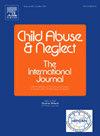在威尔士接受社会关怀和支持的残疾儿童和与安置到护理相关的因素:一项基于人口的数据链接研究
IF 3.4
2区 心理学
Q1 FAMILY STUDIES
引用次数: 0
摘要
目的确定威尔士(2017-2021年)接受照顾和支持的儿童中残疾的普遍程度,并根据他们的照顾状况(照顾/不照顾)检查不同残疾组合的残疾儿童的比例。调查与这些儿童安置有关的风险因素。方法使用安全匿名信息链接数据库中保存的儿童受照顾和支持人口普查记录,该数据库与人口统计记录和儿童受照顾人口普查相关联。我们使用条形图和颠覆图进行数据可视化,并进行多变量逻辑回归分析,以模拟与残疾儿童被安置在护理中心相关的因素。结果在37765名接受照顾和支持的儿童中,有10720名(28%)残疾儿童,3385名(32%)残疾儿童得到照顾。最常见的障碍是风险感知(44%)和心理健康问题(41%)。与≥16岁的儿童相比,1岁的婴儿更有可能进入护理(优势比3.00,95%可信区间1.93-4.66)。与白人儿童相比,黑人儿童(1.64,(1.09-2.42))、混血儿童(2.34,(1.77-3.08))或“其他”种族儿童(1.81,(1.16-2.77))更容易进入托儿所。儿童心理健康问题与进入护理中心有关(1.82(1.60-2.07)),以下父母因素也与之相关:精神疾病(1.45(1.31-1.62))、物质/酒精滥用(3.23(2.87-3.64))、学习障碍(2.97(2.56-3.45))和家庭暴力(1.47(1.30-1.65))。结论:这一新颖的、人口范围的证据将有助于为残疾儿童及其家庭提供有针对性的护理和支持,以帮助防止儿童进入护理。本文章由计算机程序翻译,如有差异,请以英文原文为准。
Disabilities in children receiving social care and support in Wales and factors associated with placement into care: A population-based data linkage study
Objectives
To determine the prevalence of disability amongst children receiving care and support in Wales (2017–2021), and examine the proportion of disabled children with different combinations of disabilities, by their care status (in care/not in care). To investigate risk factors associated with placement in care amongst these children.
Method
We used Children Receiving Care and Support Census records held in the Secure Anonymized Information Linkage Databank linked to demographic records and the Children Looked After Census. We used bar charts and UpSet plots for data visualization and conducted multivariable logistic regression analyses to model factors associated with disabled children being placed in care.
Results
Of 37,765 children receiving care and support, 10,720 (28 %) had a disability and 3385 (32 %) disabled children were placed in care. The most common impairments were risk perception (44 %) and mental health problems (41 %). Infants <1 year were more likely to enter care compared with children aged ≥16 (Odds Ratio 3.00, 95 % Confidence Interval 1.93–4.66). Black children (1.64, (1.09–2.42)), and children of mixed (2.34, (1.77–3.08)), or ‘other’ (1.81, (1.16–2.77)) ethnicity were more likely to enter care compared with White children. Child mental health problems were associated with entering care (1.82 (1.60–2.07)) as were the following parental factors: mental ill health (1.45 (1.31–1.62)), substance/alcohol misuse (3.23 (2.87–3.64)), learning disabilities (2.97 (2.56–3.45)), and domestic abuse (1.47 (1.30–1.65)).
Conclusions
This novel, population-wide evidence will contribute to the planning and provision of targeted care and support for disabled children and their families, to help prevent children entering care.
求助全文
通过发布文献求助,成功后即可免费获取论文全文。
去求助
来源期刊

Child Abuse & Neglect
Multiple-
CiteScore
7.40
自引率
10.40%
发文量
397
期刊介绍:
Official Publication of the International Society for Prevention of Child Abuse and Neglect. Child Abuse & Neglect The International Journal, provides an international, multidisciplinary forum on all aspects of child abuse and neglect, with special emphasis on prevention and treatment; the scope extends further to all those aspects of life which either favor or hinder child development. While contributions will primarily be from the fields of psychology, psychiatry, social work, medicine, nursing, law enforcement, legislature, education, and anthropology, the Journal encourages the concerned lay individual and child-oriented advocate organizations to contribute.
 求助内容:
求助内容: 应助结果提醒方式:
应助结果提醒方式:


